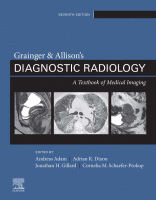Physical Address
304 North Cardinal St.
Dorchester Center, MA 02124

Introduction Noninvasive cross-sectional imaging with computed tomography angiography (CTA) and magnetic resonance angiography (MRA) plays a crucial role in the diagnosis and preintervention assessment of patients with vascular disease. Because imaging of vascular disease imposes stringent requirements in terms of…

Normal Brain Maturation Brain maturation is assessed by observing tissue characteristics related to myelination, as well as variations in morphology. Most of the changes associated with myelination occur in the first 2 years of life, and gyral and sulcal development…

This chapter should be read in conjunction with the descriptions of bone tumours in adults (see Chapters 40 and 41 ). Bone Tumours The most common presenting symptom of bone neoplasms is skeletal pain. Plain radiography remains the first diagnostic…

Fractures account for up to 25% of all injuries in children, being commoner in boys. The type and distribution of injuries vary throughout childhood. There are significant differences in the type of fractures seen in adults because of the difference…

Constitutional Disorders of Bone Nomenclature The naming of constitutional disorders of bone can be confusing. Constitutional bone disorders include osteochondrodysplasias and dysostoses. Osteochondrodysplasias consist of dysplasias (abnormalities of bone and/or cartilage growth) and osteodystrophies (abnormalities of bone and/or cartilage texture).…

Overview In this chapter, we cover the important areas of renal, urinary tract and pelvic imaging in children, emphasising the importance of congenital abnormalities and the need for minimising radiation burden and optimising image quality. Ultrasound (US) is the preferred…

Introduction Paediatric gastrointestinal (GI) radiology is most appropriately approached and dealt with according to the age of the patient, and for this reason the chapter has been subdivided into sections; the first details neonatal pathology and the latter relates to…

The Neonatal Chest Normal Anatomy and Artefacts The anteroposterior (AP) diameter of the neonatal chest is almost as great as its transverse diameter, giving the chest a cylindrical configuration. The degree of rotation is best assessed by comparing the length…

Medical diagnostic imaging has evolved and rapidly improved over the past five decades as a result of novel developments in diagnostic digital imaging and interventional techniques. With technical advances in computer processing power, high-resolution display monitors/workstations, increased computing power and…

Personalised Medicine in Oncology One of the major aims of oncological imaging is to detect and differentiate a tumour from normal tissue and thus it is necessary to understand the fundamental cellular changes that occur when a tumour forms, and…